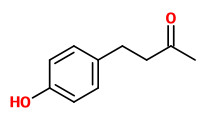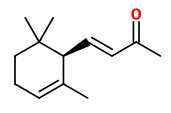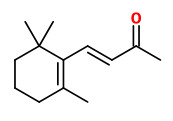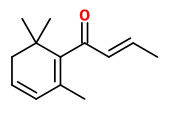Dies ist eine alte Version des Dokuments!
Rubus idaeus L. - Rosaceae - raspberry, wild raspberry, red raspberry, European raspberry, Himbeere
Shrub native to Eurasia, 1-2m high, cultivated for fruit; stem green, erect, often spiny; leaves pinnate (5-7 leaflets); leaves below white hairy; flowers white; berries red.
„Plants of Rubus idaeus are generally perennials which bear biennial stems („canes“) from a perennial root system. In its first year, a new, unbranched stem („primocane“) grows vigorously to its full height of 1.5-2.5 m, bearing large pinnately compound leaves with five or seven leaflets, but usually no flowers. In its second year (as a „floricane“), a stem does not grow taller, but produces several side shoots, which bear smaller leaves with three or five leaflets.“ http://en.wikipedia.org/wiki/Rubus_idaeus
„Volatile components of fresh wild raspberries were studied by combined gas chromatographymass spectrometry. A total of 75 components were identified, corresponding to about 64 ppm of raspberry oil in the press juice. More than 40 compounds not reported previously as raspberry volatiles were detected. These included 5-methyl-4-hydroxy-3(2H)furanone, 2,5-dimethyl-4-hydroxy-3(2H)furanone, 2,5-dimethyl-4-methoxy-3(2H)furanone, and 11 terpenes. Two of the identified esters, ethyl 5-hydroxyoctanoate and ethyl 5-hydroxydecanoate, have not previously been identified in natural products. These esters are very unstable, forming the corresponding δ-lactones during processing of the berries.“
[The aroma of finnish wild raspberries, Rubus idaeus, L., Honkanen, E., Pyysalo, T., Hirvi, T., Zeitschrift für Lebensmittel-Untersuchung und Forschung, 171(3), 1980, 180-182]
„The content of aroma compounds in 10 different raspberry varieties was examined and compared with sensory evaluation of jam made of these varieties. Raspberry ketone (4-(4-hydroxyphenyl)-butane-2-one) and α- and β-ionone were found to be the most important aroma compounds for all the varieties while linalool and geraniol were found in considerable levels in some varieties. The pure raspberry aroma was found to depend on a relatively high content of the raspberry ketone. If other compounds were present in relatively high amounts the sensory impression was flowery or like synthetic raspberry flavour. In some varieties the level of oxidation products as acetoin and hexanoic acid was high. These compounds have very high odour threshold values but at the sensory evaluation it was shown that they may suppress the raspberry flavour.“
[Relations between the content of aroma compounds and the sensory evaluation of 10 raspberry varieties (Rubus idaeus L). Larsen, Mette, et al., Acta Agriculturae Scandinavica 41.4 (1991), 447-454]
 raspberry ketone |  (R)-(+)-(E)-α-ionone |  β-ionone |  damascenone |
Natural α-ionone found in R.idaeus was in approximately optically pure (R)-(+) form.
[Chirospecific analysis in flavor and essential oil chemistry Part B. Direct enantiomer resolution of frans-α-ionone and trans-α-damascone by inclusion gas chromatography., Werkhoff, P., Bretschneider, W., Güntert, M., Hopp, R., Surburg, H., Zeitschrift für Lebensmittel-Untersuchung und Forschung, Vol.192(2), 1991, 111-115]
Aroma extract dilution analysis (AEDA) of raspberry cultivars from U.S. showed β-ionone, 2,5-dimethyl-4-hydroxy-3-(2H)-furanone (strawberry furanone), 2-ethyl-4-hydroxy-5-methyl-3-(2H)-furanone, 5-ethyl-3-hydroxy-4-methyl-2-(5H)-furanone (maple furanone), dimethyl sulfide, hexanal, β-pinene,and (E)-β-ocimene to have highest FD factors (>=1024).
[Aroma extract dilution analysis of cv. Meeker (Rubus idaeus L.) red raspberries from Oregon and Washington., Klesk, K., Qian, M., Martin, R.R., Journal of agricultural and food chemistry, 52(16), 2004, 5155-5161]
„Of the 230 volatiles characterised in raspberry, only 12 have been identified as of character impact (Jiang 1991; Larsen et al. 1991): α- and β-ionone, α-ionol, β-damascenone, linalool, geraniol, (Z)-3-hexenol, benzyl alcohol, acetoin, raspberry ketone, acetic and hexanoic acids… As in grape (Camara et al. 2004), α-, β-ionones, α-ionol and β-damascenone (C13 norisoprenoid volatiles) are important for flavour. These
are formed by carotenoid breakdown (Winterhalter and Rouseff 2002) via the plastidial pathway (Hampel et al. 2007) and confer desirable ‘‘berry’’, ‘‘honey’’, ‘‘sweet’’ and ‘‘rose’’ notes to fruit.“
[Environmental and seasonal influences on red raspberry flavour volatiles and identification of quantitative trait loci (QTL) and candidate genes. Paterson, Alistair, et al., Theoretical and Applied Genetics 126.1 (2013), 33-48]

Thomé,O.W., Flora von Deutschland Österreich und der Schweiz, Tafeln, vol.3 t.397 (1885)
http://plantgenera.org/species.php?id_species=890475

